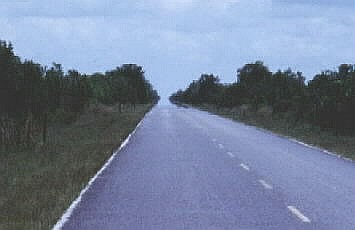
"Floating Island" on Bonneville Salt Flats, Utah.
There is no water anywhere on this picture;
the mountain in the distance appears to be in a lake due to the mirage.
Mirage Page
(all photographs by J. Gerencher)
Mirages are formed when there is a strong vertical temperature gradient near the ground. Under these circumstances, light rays are bent from a straight path. If the ground is hotter than the air above, the rays are bent upward so that portions of the sky appear on the ground as puddles or lakes. If the surface is colder than the air above it, then distant objects can appear doubled into both the original image and an inverted, horizontal mirror image.

"Floating Island" on Bonneville Salt Flats, Utah.
There is no water anywhere on this picture;
the mountain in the distance appears to be in a lake due to the mirage.

Notice how the highway seems to disappear in the distance,
but the vegetation along the highway edge gives evidence that
the horizon is actually much farther away. This scene was photographed
on a hot summer day in the
Everglades National Park, Florida.

Looming islands in the distance appear to have flat tops.
The cold water has created a cool layer of air adjacent to the surface.
Bay of Fundy, Nova Scotia, Canada